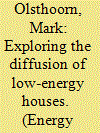|
|
|
Sort Order |
|
|
|
Items / Page
|
|
|
|
|
|
|
| Srl | Item |
| 1 |
ID:
137658


|
|
|
|
|
| Summary/Abstract |
As countries move toward larger shares of renewable electricity, the slow diffusion of active electricity load management should concern energy policy makers and users alike. Active load management can increase capacity factors and thereby reduce the need for new capacity, improve reliability, and lower electricity prices. This paper conceptually and empirically explores barriers to load shift in industry from an end-user perspective. An online survey, based on a taxonomy of barriers developed in the realm of energy efficiency, was carried out among manufacturing sites in mostly Southern Germany. Findings suggest that the most important barriers are risk of disruption of operations, impact on product quality, and uncertainty about cost savings. Of little concern are access to capital, lack of employee skills, and data security. Statistical tests suggest that companies for which electricity has higher strategic value rate financial and regulatory risk higher than smaller ones. Companies with a continuous production process report lower barrier scores than companies using batch or just-in-time production. A principal component analysis clusters the barriers and multivariate analysis with the factor scores confirms the prominence of technical risk as a barrier to load shift. The results provide guidance for policy making and future empirical studies.
|
|
|
|
|
|
|
|
|
|
|
|
|
|
|
|
| 2 |
ID:
191237


|
|
|
|
|
| Summary/Abstract |
Legislative proposals intend to require that manufacturers provide consumers with information on product life-cycle impacts. Yet, little is known about how consumers value such life-cycle information and who would be most sensitive to it. In this paper, we employ data from a demographically representative household survey among the adult population in Germany (N = 404), which elicits individuals’ preferences for energy-related attributes of refrigerators. Based on mixed logit analysis of a discrete choice experiment, we find that consumers, on average, dislike refrigerators with much higher embodied energy, value the highest energy class, and prefer refrigerators with longer warranty periods. Latent class models distinguish three consumer classes: 'price sensitives' (36%), 'quality seekers' (24%) and 'energy savers' (40%). 'Energy savers' are characterized by a higher environmental identity, energy literacy, and more patience than the other classes. Rating scales reveal that consumers consider life-cycle properties with direct, private benefits much more strongly than properties with mainly indirect, social benefits. Results from ordered logit models suggest that women with more patience and high environmental identity consider all life-cycle properties more strongly, while durability appears to also be valued more by low-income and more energy literate consumers. The results support ongoing policy initiatives that require the provision of life-cycle information and call for instruments to help consumers select appliances based on life-cycle costs.
|
|
|
|
|
|
|
|
|
|
|
|
|
|
|
|
| 3 |
ID:
166462


|
|
|
|
|
| Summary/Abstract |
Diffusion of low-energy houses is an important part of energy and climate policy in the European Union (EU) and in individual EU countries. Key barriers to the adoption of low-energy houses include additional construction costs and uncertainty surrounding actual energy and cost savings.
|
|
|
|
|
|
|
|
|
|
|
|
|
|
|
|
|
|
|
|
|